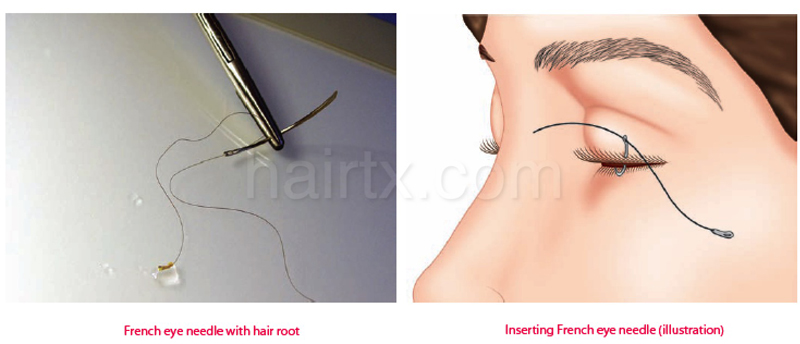Eyelash Hair Restoration
Eyelashes provide an aesthetic frame to the eye but, more importantly, can help functionally to prevent dust and debris from entering the eyes. Although some surgeons perform eyelash transplant simply for cosmetic purposes, Dr. Lam truly believes that these results are far unsatisfactory both in terms of hair density and naturalness. Instead, Dr. Lam believes in agreement with world experts that an eyelash transplant should be reserved for functional problems such as for individuals who are born without eyelashes r who have lost enough of their eyelashes so as to cause functional issues with their eyes. Instead today, there are better methods to thicken weaker eyelashes or to restore partially lost eyelashes through Latisse (a prostaglandin topical treatment) and eyelash extensions, respectively. Dr. Lam can prescribe you Latisse but does not perform eyelash extensions. A consultation with Dr. Lam will help determine whether you are a candidate for eyelash hair transplant.
Although this procedure has inherent appeal, Dallas hair transplant surgeon Dr. Sam Lam reserves his eyelash transplants for individuals who need this surgery for reconstructive purposes. He believes that eyelash growth sera like his Folliflo provide more natural and easily attainable results than achievable with eyelash transplant. However, in individuals with serious loss of hair due to burns and trauma, eyelash transplantation can provide a vital component to eye protection.
Schedule your consultation today!
Key Points
- Ideal candidate

- Men and women who were born with weak eyelashes or have lost their eyelashes due to any type of injury and have functional problems, i.e., cannot keep dust or debris out of their eyes, can be considered for this procedure
- What to do
- Schedule your procedure and plan on one week for recovery during which time you are functional but may not be socially presentable for 3 to 7 days.
- If you are from out of town, you will be required to arrive the day before the procedure and will be allowed to travel the day after, staying in town for a total of two nights. However, if you are not in town at two weeks after the procedure, you will need a professional to remove your sutures (stitches). Dr. Lam has many colleagues across the United States and the world who may be able to help remove your sutures so that you do not need to stay in Dallas for two weeks or return in two weeks to have your sutures removed.
- What to expect
- You may have swelling around the eyes that may last 3 to 7 days. Due to healing and tiny scabs around transplanted hairs, your eyelids may feel heavy and tighter for a week.
- You can wear a hat and sunglasses immediately after the procedure, and you can wash your hair and eyelashes 24 hours afterward. You can travel the next day.
- Your stiches should be removed 2 weeks post-procedure, and we will help you schedule your appointment.
- Transplanted hair should start growing 3 to 4 months post-procedure and should improve in growth up to 12 months post-procedure.
- You will need to trim your eyelash hairs weekly. The hair growth cycle for eyelash hairs lasts 4 to 6 weeks, while the hair growth cycle for scalp hairs is 3 to 5 years. This means that eyelash hairs fall out after they reach a certain length, while scalp hairs will grow longer and need to be trimmed on a regular basis. Since scalp hairs are used to transplant lost eyelashes, hairs will need to be trimmed weekly.
- How Much Does it Cost?
- Dr. Lam will perform an analysis of your eyelashes during your consultation to help determine an appropriate treatment plan with your unique needs in mind. He will then discuss the details of the treatment and the cost associated with it.
FAQs
-
What technique does Dr. Lam use to transplant eyelashes?
Dr. Lam uses a technique of “reverse FUE”. This method involves making a flap in the donor area (back of the head) and the hairs left long are pulled out from the skin’s undersurface. These hairs are then threaded onto a curved needle and pulled through the eyelid. The reason for employing this technique is to ensure that the eyelash curves correctly or else there will be a risk of trichiasis, i.e., eyelashes curling the wrong way, which would in turn cause functional problems, like scratching the cornea.

-
What if I am not willing to trim my eyelash hairs every week or so?
Then, you should not have the procedure performed. Although in some cases eyelash hair growth slows down after several years to mimic the growth rate of native eyelash hairs, this cannot be guaranteed. To alleviate some of your concern, the special eyelash scissors that Dr. Lam provides to you at no extra charge are very easy to use and with blunt tips make the trimming very safe and very fast.
-
Is one procedure good enough to attain adequate hair density?
Because eyelashes are restored in a very delicate region of the eyelid, sometimes hairs compete for blood supply and a few grafts may not survive, leaving occasionally visible gaps. Some people see these gaps as insignificant, while others choose a touch-up session.




